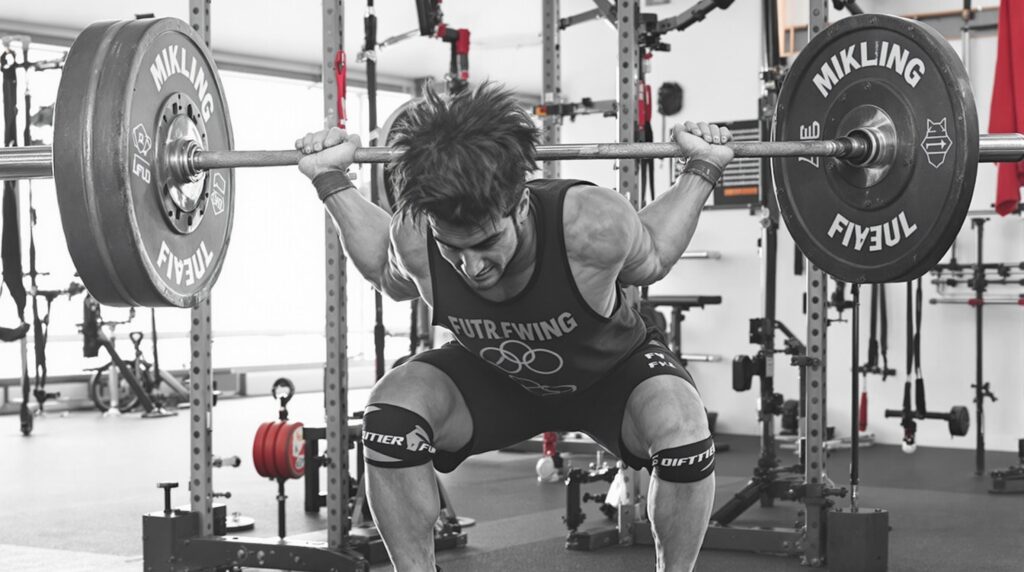The Airdyne bike combines full-body resistance with fan-based technology to deliver one of the most effective cardio workouts available today. An airdyne bike workout can torch up to 87 calories per minute at maximum effort, making these machines popular choices for those seeking efficient fat loss and improved conditioning in minimal time.
Key Takeaways
- Airdyne bikes provide progressive resistance that automatically adjusts to your effort level
- High-intensity intervals on an air bike create an EPOC effect, burning calories for hours after your workout
- These machines engage multiple muscle groups simultaneously, maximizing workout efficiency
- The seven workout routines range from beginner-friendly to elite athlete challenges
- Consistent tracking of metrics (watts, calories, distance) allows for measurable progress over time
Introduction to the Airdyne Bike
The Airdyne bike stands apart from traditional exercise bikes with its unique fan-based resistance system. Originally introduced by Schwinn in the 1970s, these bikes have evolved into modern powerhouses like the Assault AirBike and Rogue Echo Bike. The genius behind their design lies in the simple principle: the harder you push, the more resistance you feel.
What makes these machines so effective is their ability to deliver a true full-body workout. Unlike traditional stationary bikes that only work your legs, Airdyne bikes engage your arms, shoulders, chest, and back simultaneously through the moving handlebars. This comprehensive muscle engagement leads to greater caloric burn and improved total-body conditioning.
The console displays offer immediate feedback on calories, watts, distance, and speed—metrics that help you track progress and push your limits. The beauty of these machines is their accessibility; they’re suitable for everyone from first-time exercisers to CrossFit champions looking for elite conditioning tools.

The Science Behind Fan Bike Effectiveness
Air bikes deliver impressive results through several physiological mechanisms. First, the high-intensity intervals typical of an airdyne bike workout trigger Excess Post-exercise Oxygen Consumption (EPOC), commonly known as the “afterburn effect.” This means your body continues burning calories at an elevated rate for hours after you’ve finished exercising.
Research has demonstrated that 20-minute HIIT sessions on these bikes can be as effective as 45 minutes of steady-state cardio for fat loss. This time efficiency makes air bikes perfect for those with busy schedules who still want maximal results.
The simultaneous engagement of upper and lower body muscles creates a compound exercise effect. Each pedal stroke activates your quadriceps, hamstrings, glutes, shoulders, chest, back, and core muscles. This comprehensive muscle recruitment not only burns more calories but also improves functional strength and coordination.
Understanding the Rate of Perceived Exertion (RPE) scale is essential for these workouts. On a scale of 1-10, where 1 is very light activity and 10 is maximum effort, most airdyne bike workout protocols will have you fluctuating between different intensity levels to maximize metabolic impact.
Getting Started: Form and Safety Guidelines
Before diving into intense workouts, proper setup is crucial. Position the seat height at approximately hip level when standing next to the bike. Your legs should have a slight bend at the bottom of the pedal stroke—never fully locked out. Handlebars should allow for comfortable grip without reaching or hunching.
Maintain proper posture throughout your workout with a slight forward lean, engaged core, and relaxed shoulders. Common mistakes include excessive hunching, death-gripping the handles (which causes unnecessary fatigue), and bouncing in the seat (which reduces efficiency and can lead to discomfort).
Always begin with a proper warm-up to prepare your body for the intensity ahead:
- 5 minutes of easy pedaling at RPE 3-4
- Dynamic shoulder circles and arm swings
- Hip mobility exercises
- Gradually increase intensity for the final minute
Proper breathing technique makes a significant difference in workout quality. Establish a rhythmic breathing pattern synchronized with your movement, avoiding the tendency to hold your breath during high-intensity bursts.
Workout #1: 30/30 HIIT Sprint Intervals
This classic interval protocol delivers maximum results in minimal time. The structure is straightforward: 30 seconds of all-out effort (RPE 9-10) followed by 30 seconds of active recovery (RPE 2-3). This work-to-rest ratio challenges both your anaerobic and aerobic energy systems.
For a complete workout:
- Warm up for 5 minutes at moderate intensity
- Perform 15-20 rounds of the 30/30 protocol (15-20 minutes total)
- Cool down for 3-5 minutes
During work intervals, aim to reach 85-95% of your maximum heart rate, then allow it to recover to 60-70% during rest periods. This workout typically burns 250-350 calories per session, depending on your size and effort level.
If you’re new to this style of training, begin with 10 rounds and add 1-2 rounds weekly as your fitness improves. Track your calorie and distance metrics each session to measure progress. As noted by Muscle and Fitness, consistency with this protocol leads to significant improvements in both power output and endurance capacity.
Workout #2: Tabata Protocol for Maximum Caloric Burn
The Tabata protocol, developed by Japanese researcher Dr. Izumi Tabata, is perhaps the most time-efficient fat-burning workout available. The structure consists of 20 seconds of maximum effort (true RPE 10) followed by just 10 seconds of complete rest.
A complete Tabata set includes:
- 8 rounds of 20/10 intervals (4 minutes total)
- 2 minutes of complete recovery
- Repeat 3-4 times for a 20-30 minute workout
Dr. Tabata’s research demonstrated that this protocol led to a remarkable 170% increase in anaerobic capacity and 14% improvement in maximal aerobic capacity. When performed correctly on an airdyne bike, you can expect to burn up to 15 calories per minute during effort periods, with total session burn exceeding 450 calories.
The key to success with this workout is generating truly explosive power during the 20-second work intervals. Don’t pace yourself—the work period should feel unsustainable for anything longer than those 20 seconds. Men’s Health UK notes that this approach creates optimal metabolic stress for fat loss and conditioning improvements.
Workout #3: Pyramid Power Intervals
Pyramid intervals create a progressive challenge that tests both mental and physical stamina. This workout structure increases work interval time while decreasing rest periods before reversing the pattern:
- 30 seconds work / 30 seconds rest
- 45 seconds work / 25 seconds rest
- 60 seconds work / 20 seconds rest
- 45 seconds work / 25 seconds rest
- 30 seconds work / 30 seconds rest
Complete 3-5 full pyramid cycles for a 25-30 minute workout that typically burns 400-500 calories. The beauty of this approach is that it improves your lactate threshold—the point at which your muscles begin to fatigue rapidly—while simultaneously enhancing cardiovascular capacity.
The key metric to focus on is maintaining consistent power output (watts) throughout the increasing intervals. This creates a powerful training stimulus that leads to functional fitness improvements transferable to other activities and sports.
Sunny Health & Fitness recommends starting with 3 cycles and progressively building to 5 complete pyramids as your fitness improves. This gradual progression prevents burnout while ensuring continual adaptation.
Workout #4: 10-20-30 Protocol
Developed by researchers at the University of Copenhagen, the 10-20-30 protocol offers a scientifically-validated approach to high-intensity interval training. Despite its name, the sequence actually works in reverse:
- 30 seconds at easy pace (RPE 3-4)
- 20 seconds at moderate pace (RPE 6-7)
- 10 seconds at maximum effort (RPE 9-10)
Repeat this sequence 5 times to complete one block, then rest for 2 minutes before starting the next block. A complete workout consists of 3-5 blocks, depending on your fitness level.
Research on this protocol shows an impressive 14% improvement in VO2 max (maximal oxygen uptake) after just 7 weeks of training. What makes this approach particularly effective is its built-in warmup structure—the easy and moderate intervals prepare your body for the all-out effort, reducing injury risk while maximizing performance.
This workout is ideal for those who struggle with extended high-intensity efforts, as the maximum exertion periods last just 10 seconds. However, don’t be fooled by the short duration—when performed correctly, this workout is extremely challenging and effective.
Workout #5: Death by Calories
For those seeking a serious mental and physical challenge, the “Death by Calories” workout provides a progressively impossible challenge that will test your limits. The structure is elegantly simple but brutally effective:
- Minute 1: Burn X calories (typically start at 12-15)
- Minute 2: Burn X+3 calories
- Minute 3: Burn X+6 calories
- Continue adding 3 calories each minute until failure
The beauty of this workout is its self-limiting nature—you’ll eventually reach a point where it’s physically impossible to continue. A good target is to reach minutes 8-10 for intermediate athletes, while elite performers might push beyond 12 minutes.
This protocol is particularly effective for building mental toughness and power endurance. The escalating challenge forces your body to become more efficient at energy production and utilization. As noted by Garage Gym Reviews, this workout should be used sparingly—perhaps once every 1-2 weeks—due to its extreme intensity.
Start with a conservative initial calorie target that allows you to build momentum before hitting your limits. For most people, 12-15 calories provides an appropriate starting point, though very fit individuals might begin at 18-20 calories.
Workout #6: CrossFit-Style Challenge
“The Devil’s Tricycle” is a



